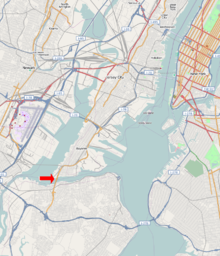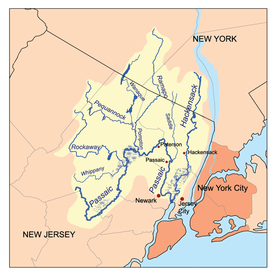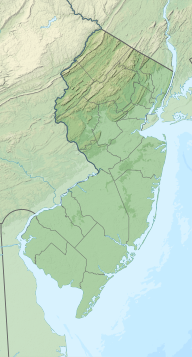Newark Bay
| Newark Bay | |
|---|---|
Port Newark is seen in the foreground looking northeast across the bay to Jersey City and the Manhattan borough of New York City. | |
| Location | New Jersey |
| Coordinates | 40°40′47″N 74°07′53″W / 40.679597°N 74.131451°W |
| Type | Bay |
Newark Bay is a
Geography

Newark Bay is rectangular, approximately 5.5 miles (8.9 km) long, varying in width from 0.6 to 1.2 miles (0.97 to 1.93 km).
The
Many of the maritime and distribution facilities along the bay are part of
Bridges
The bay is spanned by the
Shoreline
Elizabethport to the Ironbound

The western edge of Newark Bay was originally shallow tidal
The city decided to expand the port at the end of the war.
The
Kearny Point
The
Bergen Point to Droyer's Point

While there was some maritime development on the eastern banks of the bay closer
Howland Hook
The
Pollution and marine life

The bay is notoriously polluted, and it is now a Superfund site. "One blue crab in Newark Bay has enough dioxin to give somebody cancer," said David Pringle, spokesman for Clean Water Action.[21]
Both the
While illegal discharges of chemical waste have been stopped, crabbing is illegal and fishing is limited due to chemicals that remain in the sediment.[24][25]
Pronounced endocrine disruption and reproductive effects have been reported in Newark Bay
2008 Liberian freighter collision
In January 2008, a 117 ft.
See also
- Geography of New York–New Jersey Harbor Estuary
- List of bridges, tunnels, and cuts in Hudson County, New Jersey
- Marine life of New York-New Jersey Harbor Estuary
- Newark Bay rail accident
- Timeline of Jersey City area railroads
References
- ^ "US Army Corps of Engineers: Newark Bay" (PDF). Archived from the original (PDF) on 2010-05-28. Retrieved 2010-04-18.
- ISBN 978-0-88097-763-0.
- ^ Bergen Point Lighthouse Archived 2010-04-09 at the Wayback Machine, 1849-1949, New Jersey Lighthouse Society.
- ^ Grabas, Joseph A. "Land Speculation and Proprietary Beginnings of New Jersey" (PDF). The Advocate. XVI (4): 3, 20, 14. Archived from the original (PDF) on November 20, 2008. Retrieved April 15, 2010.
- ^ "PANYNJ FTZ 49". Archived from the original on 2019-10-19. Retrieved 2010-04-19.
- ^ $2B MXD Planned for Elizabeth Waterfront Archived 2012-06-12 at the Wayback Machine
- ^ "TO MAKE NEWARK BAY A BIG PORT; The Jersey Meadow's Being Transformed Into a Busy Spot, with Docks and Reclaimed Land" (PDF). The New York Times. 27 June 1915. Archived (PDF) from the original on 14 February 2022. Retrieved 14 June 2018.
- ISBN 978-0-7385-0966-2. Archived from the originalon July 18, 2011. Retrieved November 21, 2009.
- ^ "Newark Bay Shipyard". Archived from the original on 2009-09-05. Retrieved 2010-04-19.
- ^ "Newark Bay Shipyard". Archived from the original on 2010-02-23. Retrieved 2010-05-03.
- ^ "THE CITY OF NEWARK TO EXPEND $1,250,000 IN THE DEVELOPMENT OF NEWARK BAY AS A SEAPORT; Unwilling in Wait Langer for Government Aid the City Authorities Authorize the Issuance of bonds to Provide Funds for Deepening of Channel to Accommodate the Largest Vessels--Plan Endorsed by Business Men" (PDF). The New York Times. 31 July 1921.
- ^ "of New York and New Jersey". Archived from the original on 2011-06-11. Retrieved 2010-04-15.
- ^ "History - Port of New York and New Jersey - Port Authority of New York & New Jersey". Archived from the original on 2019-10-19. Retrieved 2010-04-17.
- ^ "River Terminal". Archived from the original on 2010-05-18. Retrieved 2010-04-15.
- ^ "Kearny Yard". Archived from the original on 2006-10-31. Retrieved 2010-04-15.
- ^ Hackenack Riverwalk Plan proposal 2003 Archived 2009-09-10 at the Library of Congress Web Archives
- ^ Hudson County Master Plan[permanent dead link]
- ^ "Ongoing Projects :: Port Ivory". Longleaf Lumber. Archived from the original on 2010-10-15. Retrieved 2010-04-15.
- ^ "Mariners Harbor Shipyard". Archived from the original on 2010-08-10. Retrieved 2010-05-03.
- ^ "Bethlehem Shipbuilding: List of Ships built at Staten Island". Archived from the original on 2010-02-21. Retrieved 2010-05-03.
- ^ "Outrage Over Company Backing Out of Superfund Cleanup Through Bankruptcy". NJTV News. 2017-04-18. Archived from the original on 2018-01-14. Retrieved 2018-01-14.
- ^ "Watershed Database and Mapping Projects/Newark Bay (New Jersey)." Archived 2010-05-28 at the Wayback Machine National Ocean Service, Office of Response and Restoration. Silver Spring, MD. March 2007.
- ^ "Comprehensive Conservation and Management Plan: Management of Toxic Contamination" (PDF). U.S. Environmental Protection Agency (EPA). March 1996. Archived (PDF) from the original on 2008-11-20. Retrieved 2009-04-03.
- ^ "Fish Advisories". Trenton, NJ: New Jersey Department of Environmental Protection (NJDEP). 29 May 2009. Archived from the original on 27 May 2009. Retrieved 3 April 2009.
- ^ "Blue Claw Crab Alert". NJDEP. 2009-12-02. Archived from the original on 2009-05-30. Retrieved 2010-04-19.
- PMID 20079544.
- PMID 21684236.
- .
- ^ "Accident Closes Major Shipping Channel for Hours". The New York Times. 2008-01-25. Archived from the original on 2018-01-06. Retrieved 2017-02-17.
- ^ "Federal report blames ship carrying orange juice for Newark Bay collision last year". NJ On-Line. 2009-12-09. Archived from the original on 2015-06-22. Retrieved 2015-01-16.
External links
- "Fishing for Answers in an Urban Estuary"—Teaching Guide About Newark Bay for Elementary Schools (NJDEP)
- New York–New Jersey Harbor Estuary Program—US EPA
- US EPA: Newark Bay Study 2004
- US Army Corps of Engineers: Newark Bay



